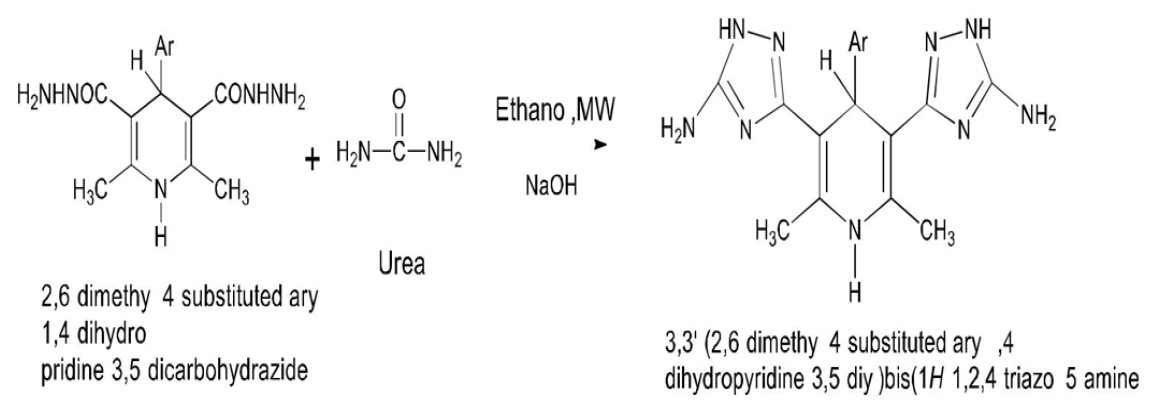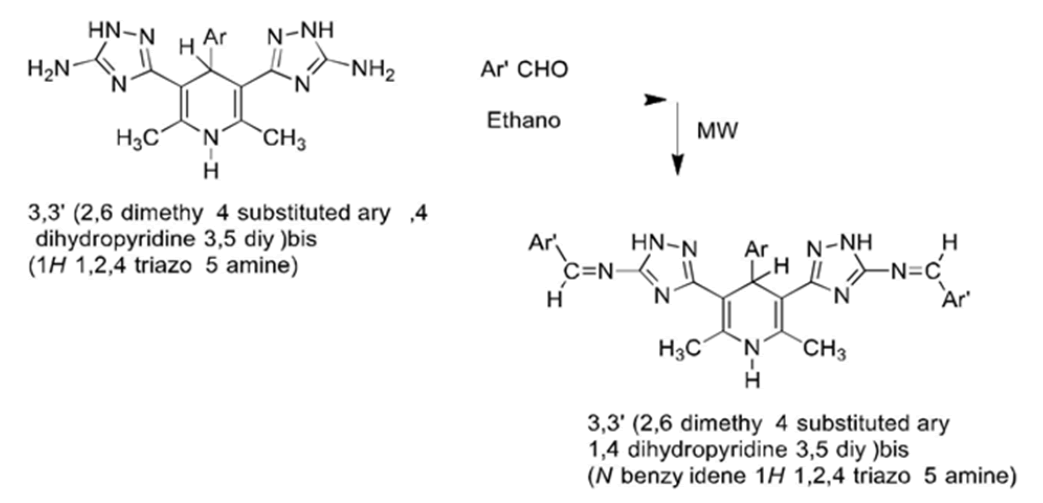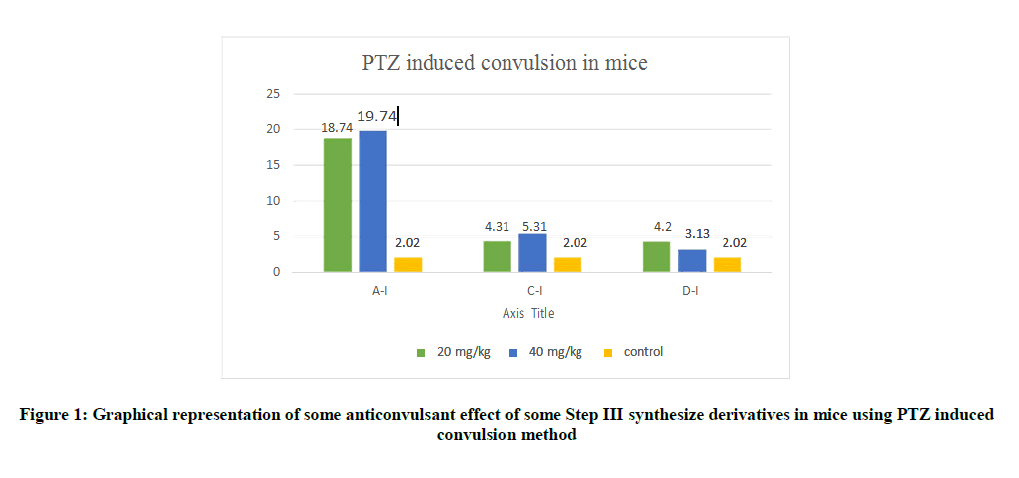Research Article - Der Pharma Chemica ( 2018) Volume 10, Issue 8
Microwave Assisted Synthesis and Evaluation for Anticonvulsant Activity of Some 1,4 Dihydropyridine Derivatives
Dinesh Rishipathak*, Luketa Alai, Kanchan Somase and Sanjay Kshirsagar
Department of Pharmaceutical Chemistry, Savitribai Phule Pune University, MET’s Institute of Pharmacy, Bhujbal Knowledge City Adgaon, Nashik. Maharashtra, India
- *Corresponding Author:
- Dinesh Rishipathak
Department of Pharmaceutical Chemistry
Savitribai Phule Pune University
MET’s Institute of Pharmacy, Bhujbal Knowledge City Adgaon
Nashik. Maharashtra, India
Abstract
Several new promising bioactive derivatives of 3,3’-(2, 6-dimethyl-4-substituted aryl-1, 4-dihydropyridine-3,5-diyl)-bis-(N-benzylidene-1H-1,2,4-triazol-5-amine) were synthesized under microwave irradiations. The compounds were obtained in excellent yields. All the titled compounds were characterized by Infrared Radiation (IR), Proton Nuclear Magnetic Resonance (1H-NMR), and mass spectral analysis. Synthesized compounds were evaluated for their anticonvulsant effect using PTZ induced convulsion studies. The pharmacological evaluation of the compounds showed increase in latency (onset time) to induce convulsions; decrease in the number of convulsions and increase in latency of death compared to control. The compounds A-I and I-II showed highest percentage of protection (80%) at the dose of 20 mg/kg among the evaluated compounds compared to control. The analysis of structural features revealed that substitution of Chloro group and methoxy group enhanced the anticonvulsant potential of the synthesized compounds.
Keywords
1,4-Dihydropyridines, 1,2,4-Triazole, Anticonvulsant, Microwave
Introduction
Microwave assisted organic synthesis (MAOS) has emerged as a new “lead” in organic synthesis. The technique offers simple, clean, fast, efficient, and economic for the synthesis of a large number of organic molecules. Important advantage of this technology include highly accelerated rate of the reaction, Reduction in reaction time with an improvement in the yield and quality of the product. Now day’s technique is considered as an important approach toward green chemistry, because this technique is more environmentally friendly [1].
Epilepsy is the most common neurological disorder in humans, affecting 1%-2% of the global population. According to World Health Organization data, approximately 50 million people worldwide, a prevalence of 50 per 100 000 of the general population, suffer from epilepsy [2]. Despite the availability of the conventional AEDs and the development of several new anticonvulsants, the treatments of epilepsy still remain inadequate since loss of effectiveness (resistance) occurs after prolonged drug exposure.
1,4-Dihydropyridine (DHP) is a molecule based upon pyridine, and the molecules that have been semi-saturated with two substituents replacing one double bond. They are particularly well known in pharmacology as L-type calcium channel blockers. Five isomeric DHPs are capable of existence, but in fact most of the known DHPs have either the 1,2-dihydro structure or the 1,4-dihydro structure. DHPs have a broad range of pharmacological actions as agents in vasodilation, bronchodilation, hepatoprotection and geroprotection and as antiatherosclerosis, antidiabetes, antitumor, antimutagenic, antioxidant, anticonvulsant and antiradical agents [3].
1,2,4-Triazoles, are five membered heterocycle with three nitrogen atoms in the ring. Triazole exists as two isomers, 1,2,3-triazoles and 1,2,4triazoles. 1,2,4-triazoles consist wide variety of pharmacological activities such as Antimicrobial, Antiinflammatory, Hypoglycemic activity, Anticonvulsant, Antifungal, Antitubercular and Antidepressant.
Materials and Methods
All the chemicals and solvents used were purchased either from Thomas Baker, LobaChemie and Sigma-Aldrich. Reagents used were of analytical grade. Thin Layer Chromatography (TLC) was performed on 60 F254 silica gel plates (Merck) and visualized under UV light. Infrared (IR) spectra were recorded on DRS on a shimadzu 1000 Fourier-transform infrared (FTIR) spectrometer in the range of 4000-200 cm-1 and only intense peaks are reported [4-6]. Proton Nuclear Magnetic Resonance (1H-NMR) spectra were recorded with a Bruker Avance II 400 NMR Spectrophotometer using CDCl3 solvent, at SAIF, Punjab University, Chandigarh. Tetramethylsilane (TMS) is used as an internal standard. All the chemical shifts were reported in δ (ppm). The Proton Nuclear Magnetic Resonance (1H-NMR) chemical shifts and coupling constants were determined assuming first-order behavior. Mass spectra were recorded with a PE Sciex model API 3000 instrument.
Synthetic scheme
Synthesis of 3,5-di-carbo-methoxy-1,4-di-hydro-2,6-dimethyl-4-(substituted aryl)-pyridine (Hantzsch-dihydropyridine synthesis)[4]

Synthesis of 1,4-dihydropyridine derivatives: A mixture of methyl acetoacetate, concentrated ammonia and substituted aldehyde (2: 1: 1 mole) in ethanol was irradiated under microwave. To the resulting mixture crushed ice was added and stirred vigorously, and filtered. The crude solid product obtained was air dried and recrystallized from ethanol. Purity of the product was checked by TLC.
Synthesis of 2,6-dimethyl-4-substituted saryl-1,4-dihydropridine-3,5-dicarbohydrazide

Synthesis of 2,6-dimethyl-4-substituted aryl-1,4-dihydropridine-3,5-dicarbohydrazide: A mixture of 3,5-dicarbomethoxy-1,4-dihydro-2,6-dimethyl-4-(substituted phenyl)-pyridines were irradiated with hydrazine hydrate (99%) (1: 2) in ethanol under microwave at 15-20 min for 590 W. The reaction mixture was cooled to room temperature, poured into crushed ice & stirred vigorously. Solid thus obtained was filtered, air dried and recrystallized from Ethanol. Purity of the product was checked by TLC.
Synthesis of 3, 3’-(2, 6-dimethyl-4-substituted aryl-l, 4-dihydropyridine-3,5-diyl)-bis-(1H-1,2,4-triazol-5-amine)

Synthesis of 3,3’-(2,6-dimethyl-4-substituted aryl-l,4-dihydropyridine-3,5-diyl)-bis-(1H-1,2,4-triazol-5-amine): A mixture of 1 mole of hydrazide of 1,4-DHP and 2 mole of urea in ethanol was irradiated under microwave for 20-25 min at power 490 W. 15 ml of 4% NaOH solution was added to the above solution. Then it was acidified with conc. HCl to obtain the product as precipitate. The solid thus obtained was filtered, air dried and recrystallized using ethanol. Purity of the product was checked by TLC.
Synthesis of 3,3’-(2,6-dimethyl-4-substituted aryl-1,4-dihydropyridine-3,5-diyl) bis-(N-benzylidene-1H-1,2,4-triazol-5-amine)
Reaction-

Synthesis of 3, 3’-(2, 6-dimethyl-4-substituted aryl-1,4-dihydropyridine-3,5-diyl)-bis-(N-benzylidene-1H-1,2,4-triazol-5-amine)
A mixture of 1 mole of triazoles of 1,4-dihydropyridines and 2 mole of substituted aldehydes in ethanol was irradiated under microwave for 25-35 min at power 420 W. The reaction mixture was cooled to room temperature, poured into crushed ice and stirred vigorously. Solid thus obtained was filtered, air dried and recrystallized from Ethanol. Purity of the product was checked by TLC.
Pharmacological evaluation: All the experiments were conducted according to the guidelines of Committee for Purpose of Control and Supervision of Experiments on Animals (CPCSEA), Ministry of Environments and Forests, Government of India with their procedures and protocols reviewed and approved by the Institutional Animal Ethical Committee (IAEC), constituted under CPCSEA. Swiss Albino male mice, weighing 22-30 g were used for the study. The animals were purchased from Hafkine’s Institute, at Parel, Mumbai, India. Animals were housed in registered animal house of MET’s Institute of Pharmacy, Nashik (Registration no.1344/ac/10/CPCSEA). Ambient temperature of 25 ± 1ºC, relative humidity of 45%-55% and 12 h light: 12 h dark cycles were maintained in the animal house. The animals had free access to water and standard pelleted diet except during experimentation food and water was withheld.
Acute toxicity studies: OECD guidelines (no. 425) were followed for acute toxicity studies. Acute intraperitoneal (i.p.) toxicity test was carried out for determining median Lethal Dose (LD50). Animals were dosed two at a time at a minimum of 48 h intervals. Doses were selected from the sequence 2000, 550, 175, 55, 17.5, 5.5, 1.75 mg/kg with 5 animals per group. Each animal was observed carefully for the signs of toxicity as well as for mortality in the first 30 min after dosing and then occasionally for further 4 hours and daily thereafter for a period of 14 days. The number of mice dying during 48 hours period was recorded.
Anticonvulsant activity (PTZ induced convulsion method) (Table 1): The drugs were freshly prepared. Pentylenetetrazole (Dose: 80 mg/kg, i.p.), a stock solution containing 8 mg/ml was prepared by dissolving it in distilled water. Diazepam (Dose: 2 mg/kg, i.p.), a stock solution containing 0.2 mg/ml was prepared by dissolving it in distilled water. All the test compounds were insoluble in water hence they were dissolved in DMSO. The doses of test compounds were 20 mg/kg, i.p. and 40 mg/kg, i.p. of Step III (Figure 1) derivatives and 1 mg/kg i.p. and 2 mg/kg i.p. of Step IV (Figure 2) derivatives respectively. The injection volume was 1 ml/100 g of body weight of animal.
| Code | Dose (mg/Kg, i.p.) |
Latency to induce convulsions (Min) | No. of convulsions | % Protection |
|---|---|---|---|---|
| PTZ (Control) | 80 | 2.02 ± 1.131 | 5 | 0 |
| Diazepam | 2 | - | 0 | 100 |
| A-I | 20 | 18.742 ± 4.798** | 2 | 60 |
| 40 | 14.074 ± 3.493* | 2 | 60 | |
| C-I | 20 | 4.315 ± 0.6903NS | 1 | 80 |
| 40 | 3.18 ± 0.4979NS | 3 | 40 | |
| D-I | 20 | 4.201 ± 0.263NS | 3 | 40 |
| 40 | 3.13 ± 0.402NS | 3 | 40 | |
| B-II | 1 | 3.79 ± 267NS | 2 | 40 |
| 2 | 7.45 ± 5.112NS | 2 | 40 | |
| C-II | 1 | 3.68 ± 0.7656NS | 3 | 40 |
| 2 | 8.44 ± 2.651NS | 2 | 60 | |
| I-II | 1 | 11.766 ± 6.189NS | 3 | 40 |
| 2 | 16.36 ± 3.819* | 2 | 60 |
N=5, in each group; *: P < 0.05; **: P <0.01; NS: Non significant; One Way ANOVA followed by Dunnett’s test. Values expressed as Mean ± SEM
Table 1: Anticonvulsant effect of some synthesized 1,4-dihydropyridines containing 1,2,4-triazoles in mice using PTZ induced convulsion method
Group of six mice were used. One group was used for studying the effects of Pentylenetetrazole alone (Control) and the other one for studying the protective effects of Diazepam (Standard). PTZ (80 mg/kg, i.p.) was administered half an hour after the administration of Diazepam and the test compounds. The test group animals were observed for onset of convulsions, number of convulsions and percentage of protection [7-11].
Results and Discussion
Synthesis of 3,5-dicarbomethoxy-1,4-dihydro-2,6-dimethyl-4-(substituted aryl)-pyridine (Hantzsch dihydropyridine synthesis) [4]
3,5-dicarbomethoxy-1,4-dihydro-2,6-dimethyl-4-(p-methoxyphenyl)-pyridine
Reaction condition- Microwave at power 420 W and irradiation time was for 55 min. Mol. Formula- C18H21NO5, Mol.wt-331.36, M.P.185-188ºC, Yield: 84%; IR (KBr) cm-1-1255 (C─O─C str) 1686 (C═O str) 3342 (N-H) 1656 (secondary amine) 1609, 1485 (C═C).
3,5-dicarbomethoxy-1,4-dihydro-2,6-dimethyl-4-phenyl-pyridine
Reaction condition: Microwave at power 490 W and irradiation time was for 20 min. Mol. Formula- C17H19NO4, Mol.wt-301.34, M.P.-182-185ºC, Yield: 66%; IR (KBr) cm-1-1730 (C═O str) 3344 (N-H) 1648 (secondary amine) 1616, 1473 (C═C).
3,5-dicarbomethoxy-1,4-dihydro-2,6-dimethyl-4-(o-chlorophenyl)-pyridine
Reaction condition-Microwave at power 490 W for 35 min, Mol. Formula C17H18ClNO4, Mol. Wt 335.78, M.P.-140-142ºC, Yield:-96%; IR (KBr) cm-1-1732 (C═O str) 3327 (N-H) 1556 (secondary amine) 1651, 1492 (C═C) 1095 (Ar-Cl).
3,5-dicarbomethoxy-1,4-dihydro-2,6-dimethyl-4-(p-chlorophenyl)-pyridine
Reaction condition-Microwave at power 420 W and irradiation time was for 35 min. Mol. Formula-C17H18ClNO4 Mol. wt-335.78, M.P.-138-140ºC, Yield: 62%; IR (KBr) cm-1-1687 (C═O str) 3483 (N-H) 1647 (secondary amine) 1624, 1498 (C═C) 1052 (Ar-Cl).
3,5-dicarbomethoxy-1,4-dihydro-2,6-dimethyl-4-(furan-2-yl)-pyridine
Reaction condition-Microwave at power 490 W and irradiation time was for 20 min. Mol. Formula- C15H17NO5, Mol.wt 291.3, M.P.-182-185ºC, Yield: 72%; IR (KBr) cm-1-1696 (C═O str) 3346 (N-H) 1653 (secondary amine) 1617, 1490 (C═C) 1147 (C-O-C).
Synthesis of 2,6-dimethyl-4-substitutedaryl-1,4-dihydropridine-3,5-dicarbohydrazide
4-(4-methoxyphenyl)-2,6-dimethyl-1,4-dihydropyridine-3,5-dicarbohydrazide
Mol. Formula- C16H21N5O3 Mol.wt-331.37; M.P.-177-179ºC Yield: 95%; IR (KBr) cm-1-1668 (C=O amide) 1251 (C─O─C str) 3320 (N-H) 1607 (secondary amine) 1607, 1472 (C═C).
2,6-dimethyl-4-phenyl-1,4-dihydropyridine-3,5-dicarbohydrazide
Mol. Formula C15H19N5O2, (C=Oamide) 3344, Mol.wt-301.34, M.P.-170-173ºC, (N-H) 1651 (secondary) Yield: 78%; IR (KBr) cm-1-1699 (amine) 1625, 1435 (C═C).
4-(2-chlorophenyl)-2,6-dimethyl-1,4-dihydropyridine-3,5-dicarbohydrazide
Mol. Formula- C15H18ClN5O2, Mol.wt-335.79, M.P. 182-184ºC, Yield: 93%; IR (KBr) cm-1-1683 (C=O amide) 3325 (N-H) 1623 (secondary amine) 1623, 1472 (C═C) 1096 (Ar-Cl).
4-(4-chlorophenyl)-2,6-dimethyl-1,4-dihydropyridine-3,5-dicarbohydrazide
Mol. Formula- C15H18ClN5O2, Mol.wt-335.79, M.P. 190-192ºC, Yield:-81%; IR (KBr) cm-1 -1697 (C=O amide) 3336 (N-H) 1627 (secondary amine) 1651, 1487 (C═C) 1099 (Ar-Cl).
4-(furan-2-yl)-2,6-dimethyl-1,4-dihydropyridine-3,5-dicarbohydrazide
Mol. Formula-C17H17N5O3 Mol.wt-291.31, M.P. 190-191ºC, Yield : 72%; IR (KBr) cm-1-1696 (C═O amide), 3351 (N-H), 1653 (secondary amine) 1627, 1491 (C═C), 1147 (C-O-C).
Synthesis of 3, 3’-(2, 6-dimethyl-4-substituted aryl-l, 4-dihydropyridine-3,5-diyl)-bis-(1H-1,2,4-triazol-5-amine)
3,3’-(4-(4-methoxyphenyl)-2,6-dimethyl-1,4-dihydropyridine-3,5-diyl)bis(1H-1,2,4-triazol-5-amine) (A-I)
Mol. Formula- C18H21N9O, Mol.wt-379.42 M.P. 168-170ºC Yield:-83%. IR (KBr) cm-1-1251 (Ar-O-R), 3295 (N-H), 1695 (=C=N), 2950 (C-H); 1H-NMR (400MHZ CDCl3) δ (ppm)=5.18 (pyridine N-H), 2.32 (-CH3), 6.77(-NH2), 10.3 (triazole), 4.95 (pyridine), 7.19 (Ar-H), 7.16 (AR-H), 3.82(-OCH3).
3,3’-(2,6-dimethyl-4-pheny-l,4-dihydropyridine-3,5-diyl)bis(1H-1,2,4-triazol-5-amine) (B-I)
Mol. Formula-C17H19N9, Mol.wt-349.39, M.P.-180-182ºC, Yield: 76%; IR (KBr) cm-1-3344(N-H), 1695 (=C=N), 2951(C-H).
3,3’-(4-(2-chlorophenyl)-2,6-dimethyl-1,4-dihydropyridine-3,5-diyl)bis(1 H-1,2,4-triazol-5-amine) (C-I)
Mol. Formula-C17H18ClN9, Mol.wt-383.84, M.P. 166-170ºC Yield: 80%; IR (KBr) cm-1-3244 (N-H), 1696 (=C=N), 2952 (C-H) 1119 (Ar-Cl); 1H-NMR (300MHZ CDCl3) δ (ppm)=5.39 (pyridine N-H), 2.17 (-CH3), 5.67 (-NH2), 9.95 (triazole), 3.61 (pyridine), 7.03 (Ar-H), 7.13 (AR-H), 7.26 (AR-H); MS (ESI) m/z (M+H) +.384.3 (C17H18ClN9), 353.2 (C15H12ClN9), 300.2 (C15H15ClN2), 272.2 (C11H14N9), 112.2 (C6H4Cl).
3,3’-(4-(4-chlorophenyl)-2,6-dimethyl-1,4-dihydropyridine-3,5-diyl)bis(1 H-1,2,4-triazol-5-amine) (D-I)
Mol. Formula- C17H18ClN9, Mol.wt-383.84, M.P.184-186ºC, Yield: 95%; IR (KBr) cm-1-3344 (N-H), 1695 (=C=N), 2951 (C-H) 1099 (Ar-Cl).
3,3’-(4-(furan-2-yl)-2,6-dimethyl-1,4-dihydropyridine-3,5-diyl)bis(1H-1,2,4-triazol-5-amine) (F-I)
Mol. Formula-C15H17N9O, Mol.wt-339.36, M.P.-180-182ºC, Yield: 94%; IR (KBr) cm-1-3346 (N-H), 1696 (=C=N), 2952 (C-H) 1148 (C-O-C).
Synthesis of 3,3’-(2, 6-dimethyl-4-substituted aryl-1, 4-dihydropyridine-3,5-diyl) bis-(N-benzylidene-1H-1,2,4-triazol-5-amine)
3,3’-(4-(4-methoxyphenyl)-2,6-dimethyl-1,4-dihydropyridine-3,5-diyl)bis(N-benzylidene-H-1,2,4-triazol-5-amine) (A-II)
Mol. Formula-C32H29N9O, Mol.wt-555.63, M.P.-180-181ºC, Yield: 70%; IR (KBr) cm-1-1250 (Ar-O-R), 3350 (-NH), 1684 (C=N).
3,3’-(4-(4-methoxyphenyl)-2,6-dimethyl-1,4-dihydropyridine-3,5-diyl)bis(N-(2-chlorobenzylidene)-1H-1,2,4-triazol-5-amine) (B-II)
Mol. Formula-C32H27Cl2N9O, Mol.wt- 624.52, M.P.-150-154ºC; Yield: 55%; IR (KBr) cm-1-1251 (Ar-O-R), 3310 (-NH), 1685 (C=N), 1049 (Ar-Cl).
3,3’-(4-(4-methoxypheny)-2,6-dimethyl-1,4-dihydropyridine-3,5-diyl)bis(N-(4-chlorobezylidene)-1H-1,2,4-triazol-5-amine) (C-II)
Mol.Formula-C32H27Cl2N9O Mol.wt-624.52, M.P.-150-152ºC, Yield:-79%.%; IR (KBr) cm-1-1251 (Ar-O-R), 3348 (-NH), 1693 (C=N), 1095 (Ar-Cl).
3,3’-(2,6-dimethyl-4-phenyl-1,4-dihydropyridine-3,5-diyl)bis(N-benzylidene-1H-1,2,4-triazol-5-amine) (D-II)
Mol.Formula-C31H27N9 Mol.wt-525.61 M.P.-192-194ºC Yield: 72%.%; IR (KBr) cm-1–3344 (-NH), 1684 (C=N), 3027 (C-H); 1H-NMR (400 MHZ CDCl3) δ (ppm)=5.00 (pyridine-N), 2.35 (pyridine –CH3), 6.68 (-NH2), 9.87 (NH- triazole), 8.21 (C=N), 3.82 (pyridine), 7.21 (multiplet Ar-H).
3,3’-(4-(2-chlorophenyl)-2,6-dimethyl-1,4-dihydropyridine-3,5-diyl)bis(N-benzylidene-1H-1,2,4-triazol-5-amine) (E-II)
Mol. Formula-C31H26ClN90 Mol.wt-560.05 M.P.-220-225ºC Yield:-52%.%. IR (KBr) cm-1–3302 (-NH), 1701 (C=N), 1118 (Ar-Cl); 1H-NMR (400 MHZ CDCl3) δ (ppm)=5.40 (pyridine-N), 2.30 (pyridine –CH3), 9.10 (NH- triazole), 8.23 (C=N), 3.61 (pyridine), 7.22s (multiplet Ar-H).
3,3’-(4-(4-chlorophenyl)-2,6-dimethyl-1,4-dihydropyridine-3,5-diyl)bis(N-benzylidene-1H-1,2,4-triazol-5-amine) (F-II)
Mol. Formula-C31H26ClN9O, Mol.wt-560.05, M.P.-176-178ºC; Yield: 69%.%; IR (KBr) cm-1-3336 (-NH), 1697 (C=N), 1087 (Ar-Cl).
3,3’-(4-(furan-2-yl)-2,6-dimethyl-1,4-dihydropyridine-3,5-diyl)-bis-(N-benzylidene-1H-1,2,4-triazol-5-amine) (G-II)
Mol. Formula-C29H25N9O Mol.wt-515.57 M.P.-186-188ºC Yield: 72%.%;, IR (KBr) cm-1-3347 (-NH), 1686 (C=N), 1122 (C-O-C).
3,3’-(4-(furan-2-yl)-2,6-dimethyl-1,4-dihydropyridine-3,5-diyl)bis(N-(4 methoxybenylidene)-1H-1,2,4-triazol-5-amine) (H-II)
Mol. Formula-C29H25N9O3, Mol.wt-575.62, M.P.-168-170ºC, Yield:-60%.%;; IR (KBr) cm-1-3350(-NH), 1693(C=N), 1151(C-O-C).
3,3’-(4-(furan-2-yl)-2,6-dimethyl-1,4-dihydropyridine-3,5-diyl)bis(N-2-chlorobenzylidene)-1H-1,2,4-triazol-5-amine) (I-II)
Mol. Formula- C29H23Cl2N9O, Mol.wt-584.46, M.P.-168-170ºC, Yield: 60%.%;; IR (KBr) cm-1-3350(-NH), 1643(C=N), 1257(C-O-C); 1H-NMR (400 MHZ CDCl3) δ (ppm)=5.19 (pyridine-N), 2.34 (pyridine –CH3), 9.82 (NH- triazole), 8.78 (C=N), 3.94 (pyridine), 7.22 (multiplet Ar-H); MS (ESI) m/z (M+H) +. 583.5 (C29H23Cl2N9O), 473.2 (C23H19ClN9O), 378.2 (C20H17ClN5O), 204.2 (C9H6ClN4).
Pharmacological Evaluation
Formula of percentage protection [8]:

Conclusion
The 3,3’-(2,6-dimethyl-4-substituted aryl-1,4-dihydropyridine-3,5-diyl) bis-(N-benzylidene-1H-1,2,4-triazol-5-amine) derivatives was synthesize using microwave for 25-35 min at power 420 W. The structures of the compounds were confirmed on the basis of IR, 1H-NMR, and Mass analyses. The analysis of structural features revealed that substitution of Chloro group and methoxy group enhanced the anticonvulsant potential of the synthesized compounds.
Acute toxicity study was done for determining LD50. The LD50 was found to be 310.2 mg/Kg for Step III derivatives and 17.5 mg/Kg for Step IV derivatives. Two doses were selected for the anticonvulsant evaluation of the compounds, 20 and 40 mg/kg for Step III derivatives and 1 and 2 mg/kg for Step IV derivatives.
The anticonvulsant activity (PTZ induced convulsion method) of the compounds showed increase in latency (onset time) to induce convulsions; decrease in the number of convulsions. The compounds A-I and I-II showed highest percentage of protection (80%) at the dose of 20 mg/kg among the evaluated compounds compared to control.
References
- F. Mavandadi, A. Pilotti, Drug Discovery Today., 2006, 11(3/4), 165-174.
- J.B. Taylor, D.J. Triggle, (Edi.), Comprehensive Medicinal Chemistry II, Elsevier Ltd, 2006,6,279-294.
- N. Edraki, Drug Discovery Today, 14 (November), 2009, 058-1066.
- J. Clayden, Organic Chemistry, New York: Oxford University Press, 2006, 1191-1193.
- J.R. DYER, Applications of absorption spectroscopy of organic compounds, New Delhi, Prentice Hall of India. Pvt. Ltd., 2007, 33-38.
- D.L. Pavia, Spectroscopy, New Delhi, Cengage Learning India Pvt. Ltd., 2010, 37-91, 390-451, 644, 648.
- S.K. Kulkarni, Handbook of Experimental Pharmacology, New Delhi, Vallabh prakashan, 2009, 131-134.
- M. Abdel-Aziz, G.A. Abuo-Rahma, A.A. Hassan, Eur. J. Med. Chem., 2009, 44, 3480-3487.
- P. Zapater, Brain Res., 1998, 796, 311-314.
- B.K. Shoichet, I.D. Kuntz, D.L. Bodian, J. Comput. Chem., 2004, 13(3), 380-397.
- B.B. Subudhi, P.K. Panda, S.P. Swain, P. Sarangi, Acta Poloniae Pharmaceutica─Drug Research., 2009, 66(2), 147-153.




